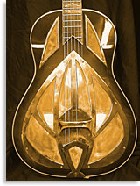
This guitar is a special project built after I was approached by the new Braunfels (Texas) Museum of Art and Music to show a guitar in an exhibit of Texas musical instrument builders. This exhibit was to coincide with a the traveling Smithsonian exhibit “Hearts and Hands,” which features photos of instrument builders. I was joined by Bill Collings, Mark Erlewine, Jamie Kinscherff, and others. I feel honored to be considered a part of this group, because these guys build great guitars.
I’ve been building more acoustic guitars recently, including a few resonators. One was for Ray Wylie Hubbard, and is pictured with him on his new album, Growl, and Kevin at Hill Country Guitars recently sold the only other one I’ve finished to date. So I decided to build one for the museum. Here’s what I came up with for them, and how I got it done.
I wanted to do something with a lot of flash, but not so much that the details would be overshadowed. Aesthetically, I wanted a teardrop-shaped cover because I think it works in the frame of a guitar’s shape. I dug out a prime piece of hard, flamey maple for the neck, back, and sides, along with an ebony fingerboard. These woods are bright and stiff, and they look cool with the right sunburst. I can choose colors to compliment the brass cover and tailpiece I’ll make later. I also decided on a tri-cone resonator mechanism, along with my standard small-bodied 12-fret slothead acoustic guitar. The top bracing was scrapped in favor of a stiff but lightweight assembly that holds the cones the required distance below the top. I used another stiff maple brace running the length of the guitar. Stiffness is always good with the load-bearing members of a guitar.
It became evident to me soon after that I would have to make a “spider” to connect the cones and support the saddle. The standard tri-cone spider orients the cones so two are on the bass side and the arm that connects the third acts as the bridge. This wouldn’t fit under my cover, so I had to fabricate a spider that puts the saddle and cones in the proper location under my cover. The spider should be stiff and lightweight, so the energy goes into the cones.
I quickly resigned myself to making a tailpiece that would recess into the cover, to put downward pressure on the saddle. A few sketches, and a few weeks later…
This article originally appeared in VG‘s April ’04 issue. All copyrights are by the author and Vintage Guitar magazine. Unauthorized replication or use is strictly prohibited.



